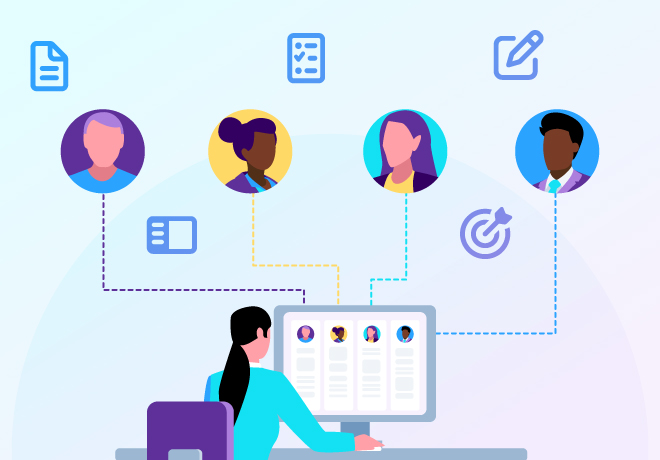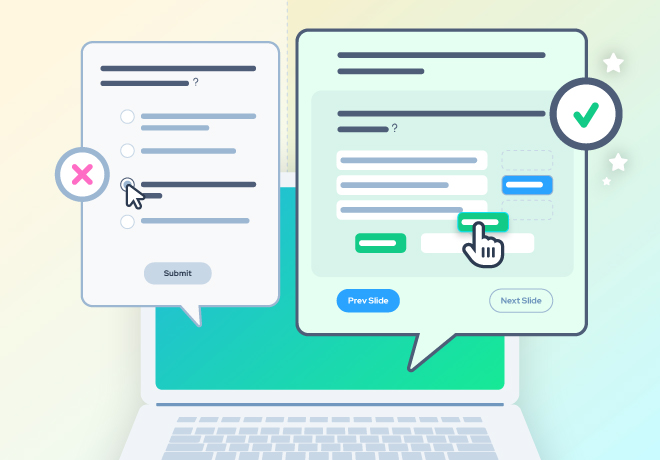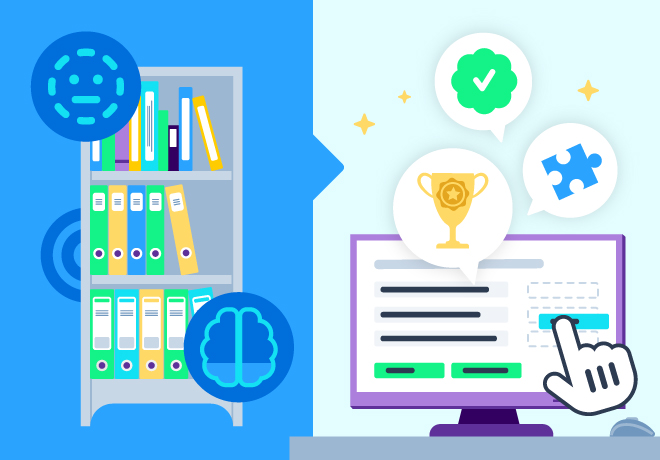
Matching LMS features to your specific training needs

Related articles
Get valuable eLearning insights to your inbox.
Listen to Neovation’s Demystifying eLearning podcast generated with NotebookLM!
Listen to our podcast on your favorite platform!
Analysis paralysis. We all suffer from it. In fact, you may be plagued by it right now. Your boss asked you to research and choose a new online learning management system (LMS). You’ve done your homework and met with a few sales representatives to understand the capabilities of various LMS platforms and their ballpark pricing. But where do you go from here?
When you don’t have time to complete a training audit
I’ve written two articles about training audits that may help you – “What is a training audit?” and “How to audit your training program?”. But you may not have time right now to conduct more than a high-level assessment of what you need. Perhaps, you’re thinking about LMS features rather than training outcomes because you are trying to compare and contrast the three LMS platforms that made it to your shortlist based on what you know right now.
At the very least, you need to be able to answer a few fundamental questions.
- What are my company’s training goals – employee onboarding, compliance training, upskilling, reskilling, or everboarding?
- How many employees need training—and what type of training do they need, based on job requirements, roles, or departments?
- What tools do you need to have built into your LMS to make training delivery as easy as possible for you/your administrators?
- Do you have content ready to go (SCORM files), or do you need to build your training content?
LMS features fall into six general categories
There are many online learning systems on the market. To reuse my favorite analogy – some are Ladas with basic functionality, some are Lincolns – more robustly featured, and some are Lamborghinis with all the bells and whistles and a price tag to match. Only you will know which type of LMS is right for you – based on budget, features, and the levels of post-sale support you will need.
Here are the six main categories and a summary of the LMS features that, in my 10+ years of experience in helping match client requirements to the right learning management system, are the ones you need to consider seriously. Keep this in mind. Your “must-have” feature is maybe someone else’s “nice-to-have” and yet another company’s “not-needed” feature.
- LMS features that enhance the learner experience
- LMS features that enhance user management
- LMS features related to training management
- LMS features related to implementation and support
- LMS features related to content management
- LMS features related to compliance and licensing
Be honest with what you need now and what you can reasonably expect to need in the future – because there is no point in buying a platform with features you will never use. I can’t possibly list ALL the features that you want – so here are the ones that I think are among the most important.
LMS features that enhance the learner experience
If your learners don’t enjoy using the platform you choose, they simply won’t engage, and training will become a grudging task they HAVE to complete when it should be an experience they look forward to. We’ve all used software with a problematic look and feel – outdated, difficult to use, and just not inspiring us to make the most of its features to reap the benefits it may provide.
Learner experience features to look for:
- Brandable login portals with the ability to have multiple sub-accounts for branches of your business if needed. Single Sign-on (SSO) functionality allows for one-click access, especially if your learners are already signing in to another work-related software as part of their everyday duties.
- Simple password resets by learners or training administrators – save time and reduce friction.
- An easy-to-navigate Knowledge Base as the repository of all their job aids and performance supports.
LMS features that enhance user management
Your training administrators have a lot to do, and user provisioning is one of those never-ending stories. By managing user profiles and permissions, content can be tailored to individual learning preferences, while learning progress can also easily be tracked. Organizing training material into learning plans and knowledge bases needs to be as friction-free as possible.
User management features to look for:
- Bulk enrollment, self-enrollment, quick user-adds, and the ability to assign learner permissions quickly and easily.
- Enhanced engagement features like intelligent gamification and accessible discussion forums and feedback forms.
- The ability to view your course catalog, their course calendar, any waiting lists they are added to, and to receive notifications for session starts and due dates.

LMS features related to training management
You want your training administration team to love the LMS you choose because they will be power users and don’t need the software to slow them down in their primary roles. Repetitive tasks quickly become tedious if there is even the slightest bit of friction. Your admins will manage users, course assignments, and progress monitoring. Big, important tasks require an LMS that delivers high-performance features to make the job as easy as possible, especially as your usage scales as your company grows.
Training management features to look for:
- Having appropriate ways for learners to enroll in courses – auto-enrollment, self-enrollment, or enrollment upon purchase if you sell your courses to third parties.
- If you need to manage instructor-led training, you’ll want features like managed waiting lists. You’ll want a platform that incorporates all aspects of ILT management into the core of its programming, not as a bolt-on that doesn’t treat ILT data as part of the whole.
- The ability to track learner activity and performance by learner, group, role, or more depends on how your training is segmented.
- A robust reporting suite and great analytics are critical.
LMS features related to implementation and support
Software onboarding, implementation, and ongoing client support should not be an afterthought. These three things are one of the most overlooked competitive differentiators when buying an LMS. The true test is how you get treated as a client by the entire LMS team versus how you are wooed, wined, and dined by a salesperson. Make sure your after-sale care plan meets your needs, and look for indicators that it will exceed expectations. Salespeople sell, and operations people deliver. If a feature. If a promise, feature, or condition isn’t explicitly included in the agreement, it won’t exist.
Implementation and support features to look for:
- A defined onboarding plan and timeline.
- Implementation services – ensure you understand the difference between “onboarding” and “implementation” – so you know what you are paying for.
- Ask for some stats on your vendor candidates’ call response and issue resolution times. Find out “who” is eligible for on-demand support services – just you? Identified administrators? Do they support end-users who have issues, and does that add to the cost? (usually, it does.)

LMS features related to content management
The success of your online training program will live or die by the quality and deliverability of your training content. Some of these features are technical, and some – like in the section above, are human, and you want to ensure a strong start and continued success. Platform functionality is one thing, but your training is only as good as the course content you offer your learners.
Content management features to look for:
- Is there a built-in course creation or eLearning authoring tool? How robust is it? Can you convert slide-style presentations into courses within the program, or do you need a third-party tool (either is acceptable, just don’t forget to ask the question.)
- How does it measure performance? Does it have quizzes, tests, and exams, in various formats like multiple choice, fill-in-the-blank, and long and short-answer questions? Are long-answer questions able to be graded by a human? Are there interactive games, flashcards, and other helpful learning tools to help build knowledge retention?
- Does it allow you to import courses from other sources easily? Is it SCORM-compatible?
LMS features related to compliance training and licensing
For many industries meeting compliance requirements is essential to doing business. Whether for health and safety protocols, manufacturing standards, or informational requirements, many businesses must ensure that they can prove to third-party auditors that training was completed – and in some jurisdictions, actual retention must also be demonstrated. Tall order – but your LMS can help you deliver and measure compliance training to ensure your employees are up to date on industry knowledge while satisfying necessary regulations and standards.
Compliance training and certification features to look for:
- Learning plans allow you to assign your team to a predetermined track of training, delivered automatically to ensure ongoing compliance. Advanced learning plan functionality will include the ability to add instructor-led training sessions as needed as well as online courses.
- If you have to manage licensing requirements, your LMS should be able to track those requirements by agency or region and CEU credits earned towards the fulfillment of licensing requirements.
- Your LMS should generate custom course completion certificates – both wall and wallet-sized, so your workers can prove they are current with their certifications.

Honorable mention: supplementary services as an LMS feature
What other additional services does your vendor offer to help you maximize your investment? It might be a better value to add things like custom content development, software integrations, or even LMS administration to your purchase rather than adding a new member to your team.
Does the vendor have their own course library, and/or do they have a partnership with another course library service? What are the costs per course? This may be especially important if your own content will take some time to create; access to a library of pre-built courses allows you to get your learners learning right away.
Does the vendor have an in-house custom course development team that can assist you in creating your own custom eLearning courses – or provide your team with additional graphic or instructional design resources as needed? How broad and robust is their skill set, and do they have specialists with a background in adult online training in a corporate setting? Can you see samples of their work?
Reducing LMS feature analysis paralysis
So, there you have it — a very high-level view of important LMS features and how they relate to enhancing the learner experience or user management (or both!). Now that you know more about what's out there, it's time to take the next step, which is more reading.
For a deeper dive into finding the fit between LMS features and your specific training needs – I recommend “How to find an LMS for your training needs”.
Then take a look at “What types of employee training can I deliver online?” – to make sure you are taking all your possible training scenarios into consideration.
As stated in my introduction, I’m working with the premise that you’ve got a short list of vendors that you’ve already talked to at least once, and the next step should be the “show and tell” portion of the buying journey. Now that you have a more clear understanding of what the various features of an LMS can do – prepare for your LMS demo just like you prepared for your LMS first sales call.
Now you’re ready to start making empowered decisions about which vendor will be the perfect partner-in-training for your company. Congratulations! You’re on your way to delivering great online training to your team.

With 15+ years of online marketing and online learning experience, Susan loves to share insights about where these two ROI-building practices can intersect and complement each other for your business or organization.
Become part of our L&D community
We publish a new learning hub article — full of useful, practical topics — weekly.
Not sure where where you want to start? Jump into one of our recently published articles and see where it takes you!








-svg.svg)
-svg.svg)
-svg.svg)
-svg.svg)